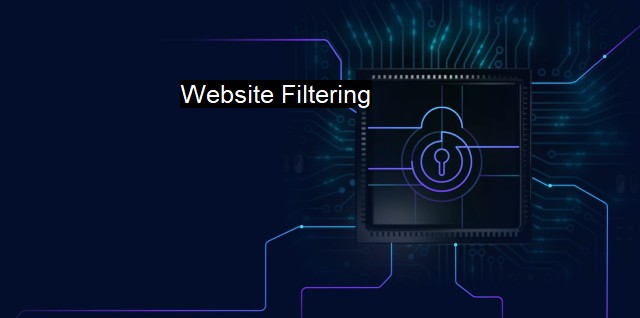What is Website Filtering?
Enhancing Cybersecurity with Website Filtering: Protecting Individuals and Organizations from Malicious Content and Attacks
Website Filtering concerns a broad array of methods that are employed to manage and regulate the Internet activity of individuals, corporations, or larger networks. As the name implies, it involves the process of sorting and blocking access to certain web content depending on specified criteria. Website Filtering is a feature that prevents harmful and inappropriate websites from being viewed on a computer or a network. This is particularly useful in various situations, such as in schools, workplaces, and households with children, ensuring a safe, productive and educational use of digital resources.The vital importance of website filters is predominantly understood when we consider the status quo of Internet activities. The World Wide Web is an ocean of information, hosting an unquantifiable volume of data in the forms of websites and digital resources. Though this vast array of information is beneficial, it is undeniable that it also hosts dangers such as malware, phishing sites, adult content, and explicit violent materials, subjecting users to a potential range of risks. These risks are where website filters pose as a populous solution.
The implementation of Website Filtering boils down to three distinct yet connected areas: URL Filtering, Content Filtering, and Time-Based Filtering.
URL Filtering is one of the most common filter types, where it blocks access to certain URL addresses that are known to host malicious content or not fit for the restricted environment. This can range from websites that contain adult content to those hosting malware and potentially harmful files.
Content Filtering, often viewed as the second layer of website filtrations, analyses web pages' content for any inappropriate words, phrases, or multimedia. Decided by pre-set criteria, if the content doesn't fit within the accepted standards, the site gets blocked. This type of filter can identify potentially dangerous or disturbing content, even if the website's URL is not included in the blacklist.
Time-Based Filtering involves setting of timers to restrict access during certain pre-defined periods. This sort of filter is most commonly implemented in environments such as school libraries, or workplaces, where Internet access limit to purely work-related, educational sites during operational hours is considered at most necessity.
In cybersecurity terms, website filtering is one of the many lines of defense to protect companies and individuals from malware or viruses that might affect their systems. Cybercriminals frequently build and design malicious websites, meant to infect a system or network with malware and viruses as soon as they’ve been visited. Website filtering acts as a sort of checkpoint, halting the path towards such harmful URLs and protecting the digital infrastructure from infection. Antivirus systems often include built-in website filtering as part of their service, offering their users an added layer of security.
Similarly have prominence at home networks, especially if there are minors onboard. Concerns like cyberbullying, online grooming, and exposure to explicit content have exponential gravity for home networks, where website filters can act as a robust watchdog delivering comprehensive safety on the digital front.
Like every technological tool, Website Filtering does pose a few drawbacks. Instances like false positives and negatives appearing, where harmless websites get flagged as harmful and vice versa, have reported. Further, in an openness and freedom of information perspective, excessive filtering can cause backlash, restricting essential content or suppressing information flow in certain environments.
Despite the drawbacks, Website Filtering will undoubtedly continue to establish a viable solution, delivering a safer, productive cyber environment for every user. The balance between security and the freedom to information is a challenge today's cyber-oriented world has to work continually upon integrating it seamlessly within our digitally-driven lives. In navigating the upsides & downsides, the fair usage of Website Filtering champions an essential tenet of cybersecurity.

Website Filtering FAQs
What is website filtering?
Website filtering is a cybersecurity measure that blocks access to specific websites and content deemed inappropriate or harmful.Why is website filtering important for cybersecurity?
Website filtering is important for cybersecurity as it helps prevent malicious sites and content from infecting devices with viruses, malware, or phishing attempts. It also helps organizations enforce internet usage policies and protect against unauthorized access to sensitive information.How does website filtering work?
Website filtering works by analyzing internet traffic and blocking access to websites based on a set of predefined criteria. This can include specific URLs, keywords, or categories of content. It can be implemented at the network level or on individual devices using software or browser extensions.What are the different types of website filtering?
There are several types of website filtering, including URL filtering, which blocks access to specific websites or web pages, content filtering, which blocks access to specific types of content such as adult or gambling sites, and DNS filtering, which blocks access to specific domains or IP addresses. Additionally, some filtering solutions use artificial intelligence or machine learning to analyze website content in real-time and block access to potentially harmful sites.| | A | | | B | | | C | | | D | | | E | | | F | | | G | | | H | | | I | | | J | | | K | | | L | | | M | |
| | N | | | O | | | P | | | Q | | | R | | | S | | | T | | | U | | | V | | | W | | | X | | | Y | | | Z | |
| | 1 | | | 2 | | | 3 | | | 4 | | | 7 | | | 8 | | |||||||